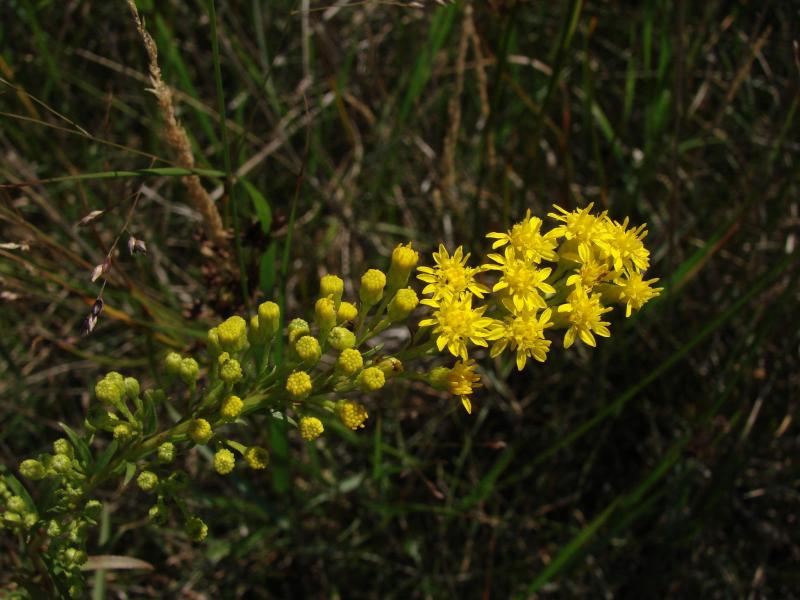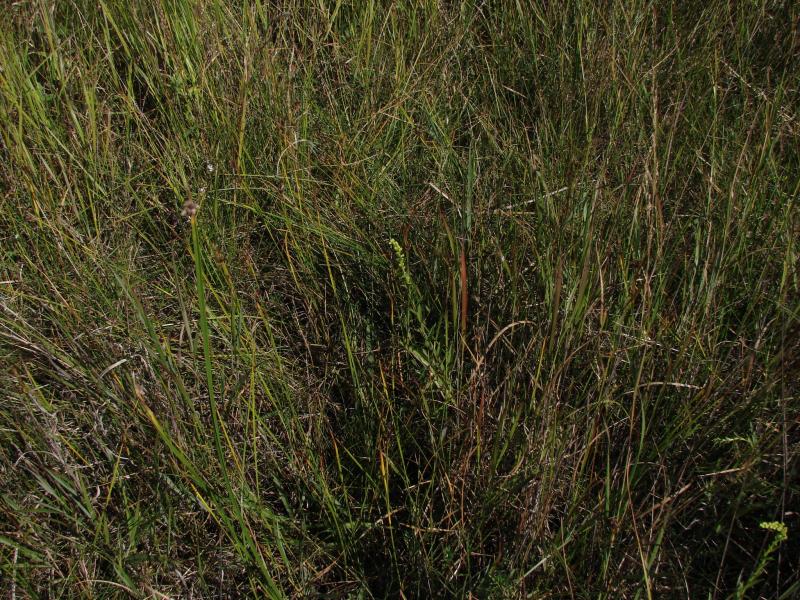Southern Seaside Goldenrod
Solidago mexicana L.
- Class
- Dicotyledoneae (Dicots)
- Family
- Asteraceae (Aster Family)
- State Protection
- Endangered
Listed as Endangered by New York State: in imminent danger of extirpation in New York. For animals, taking, importation, transportation, or possession is prohibited, except under license or permit. For plants, removal or damage without the consent of the landowner is prohibited.
- Federal Protection
- Not Listed
- State Conservation Status Rank
- S1
Critically Imperiled in New York - Especially vulnerable to disappearing from New York due to extreme rarity or other factors; typically 5 or fewer populations or locations in New York, very few individuals, very restricted range, very few remaining acres (or miles of stream), and/or very steep declines.
- Global Conservation Status Rank
- G5T5?
Secure globally (most likely) - Conservation status of the subspecies/variety is uncertain, but is most likely common in the world; widespread and abundant (but may be rare in some parts of its range). More information is needed to assign a firm conservation status. (The species as a whole is common globally.)
Summary
Did you know?
This plant may be overlooked because it is shorter and more narrow than the common variety of seaside goldenrod and may be hidden among the taller saltmarsh grasses and rushes. It was rediscovered on Long Island in 1992 after not being seen there for 70 years (Lamont 1994).
State Ranking Justification
There are three existing populations, of several hundred plants each, but these are threatened by the expansion of nearby Phragmites populations. There are seven historical populations known from the late 1800s and early 1900s that have not been resurveyed and two additional populations that are considered extirpated.
Short-term Trends
The short-term trend is unknown because no follow-up surveys have been done to existing populations.
Long-term Trends
The long-term trend is negative. This plant has always been very rare in New York but populations along the Hudson River and in the New York City area have probably been lost. Phragmites invasion may threaten the future of the existing populations.
Conservation and Management
Threats
The invasion of Phragmites threatens all existing populations.
Conservation Strategies and Management Practices
Control Phragmites invasions in the salt marshes where they occur and prevent new incursions. Natural buffers should be established around the salt marshes to decrease pollution runoff and other direct human disturbances.
Habitat
Habitat
In New York, the existing populations occur in high salt marsh with many other wildflowers and graminoids. There are three historical records from areas that could be brackish, saline, or freshwater habitats but the directions are not specific enough. (New York Natural Heritage Program 2012).
Associated Ecological Communities
- High salt marsh
(guide)
A coastal marsh community that occurs in sheltered areas of the seacoast, in a zone extending from mean high tide up to the limit of spring tides. It is periodically flooded by spring tides and flood tides. High salt marshes typically consist of a mosaic of patches that are mostly dominated by a single graminoid species.
Associated Species
- Euthamia graminifolia (common flat-topped-goldenrod)
- Iva frutescens (salt marsh-elder)
- Juncus gerardii
- Panicum virgatum (switch grass)
- Sanguisorba canadensis (Canadian burnet)
- Schoenoplectus pungens
- Spartina
Range
New York State Distribution
This saltmarsh goldenrod is currently known from Suffolk County, Long Island with historical records to the west in Nassau, Kings, Richmond, and Bronx counties. It was also known to the north in Westchester and Dutchess counties but is probably extirpated there.
Global Distribution
This saltmarsh wildflower grows along the Atlantic and Gulf coasts from Massachusetts south to Florida, west to Louisiana and the coast of Texas.
Identification Comments
General Description
Mexican seaside goldenrod is an erect to ascending wildflower that grows 4-20 dm tall from a short, stout base. The stems are hairless or may contain some hairs in the inflorescence. The basal and lower leaves are present at flowering time. They are 10-40 cm long, thick and fleshy, hairless, narrowly ovate to oblanceolate, and taper at the base to long winged petioles. The mid to upper leaves are sessile, thick and fleshy, without teeth and 4-6 cm long. They are reduced in size towards the top of the stem. There are 20-500 flower heads in broadly club-shaped inflorescences. The peduncles are 2-3 mm long with no or only a few hairs. The involucres is 3-4 mm long. The involucral bracts are in a 3-4 series with ciliate margins. The 7-11 yellow ray flowers are 5-6.2 mm long. There are 10-16 disk flowers (FNA 2002).
Identifying Characteristics
Distinguishing characteristics: leaves thick, commonly fleshy, smooth, entire; the basal broad petioled; lower cauline leaves clasping one-half to three-fourths the circumference of the stem, linear- to oblong- lanceolate, 1-3 cm broad; upper cauline leaves linear-lanceolate, frequently ciliolate; branches of panicle usually hirtellous; involucres 3-4 (rarely 5) mm high; rays 7-11; pappus 3.5-5.5 mm long; disk corollas 10- 16, 4-5.5 mm long; mature achenes 2.2-3.5 mm long. Best life stage for ID: in flower. Characteristics needed to ID: stem with leaves and flowers or mature achenes.
Best Life Stage for Proper Identification
This species can only be separated from the more common seaside goldenrod when it is in flower.
Similar Species
Common seaside goldenrod, Solidago sempervirens var. sempervirens, is much more common and has involucres 4-7 mm long with 12-17 ray flowers and 17-22 disk flowers. It occurs in a wider variety of saline habitats. There are no other closely related goldenrods (FNA 2002).
Best Time to See
Flowers late August through September, fruits mature in October.
- Flowering
- Fruiting
The time of year you would expect to find Southern Seaside Goldenrod flowering and fruiting in New York.
Southern Seaside Goldenrod Images
Taxonomy
Southern Seaside Goldenrod
Solidago mexicana L.
- Kingdom Plantae
- Phylum Anthophyta
- Class Dicotyledoneae
(Dicots)
- Order Asterales
- Family Asteraceae (Aster Family)
- Order Asterales
- Class Dicotyledoneae
(Dicots)
- Phylum Anthophyta
Additional Common Names
- Mexican Seaside Goldenrod
Synonyms
- Solidago sempervirens var. mexicana (L.) Fern.
Additional Resources
Best Identification Reference
Flora of North America Editorial Committee. 2006. Flora of North America North of Mexico. Vol. 20. Magnoliophyta: Asteridae, Part 7: Asteraceae, part 2. Oxford Univ. Press, New York. xxii + 666 pp.
Other References
Fernald, M.L. 1950. Gray's manual of botany. 8th edition. D. Van Nostrand, New York. 1632 pp.
Gleason, Henry A. and A. Cronquist. 1991. Manual of Vascular Plants of Northeastern United States and Adjacent Canada. The New York Botanical Garden, Bronx, New York. 910 pp.
Holmgren, Noel. 1998. The Illustrated Companion to Gleason and Cronquist's Manual. Illustrations of the Vascular Plants of Northeastern United States and Adjacent Canada. The New York Botanical Garden, Bronx, New York.
Lamont, Eric. 1994. Rediscovery of Solidago sempervirens var. mexicana in New York, with notes on its taxonomic history. Bull. Torrey Botanical Club 121(3): 292-294.
Mitchell, Richard S. 1986. A checklist of New York State plants. Bulletin No. 458. New York State Museum. 272 pp.
Mitchell, Richard S. and Gordon C. Tucker. 1997. Revised Checklist of New York State Plants. Contributions to a Flora of New York State. Checklist IV. Bulletin No. 490. New York State Museum. Albany, NY. 400 pp.
New York Natural Heritage Program. 2010. Biotics database. New York Natural Heritage Program. New York State Department of Environmental Conservation. Albany, NY.
New York Natural Heritage Program. 2024. New York Natural Heritage Program Databases. Albany, NY.
Weldy, T. and D. Werier. 2010. New York flora atlas. [S.M. Landry, K.N. Campbell, and L.D. Mabe (original application development), Florida Center for Community Design and Research http://www.fccdr.usf.edu/. University of South Florida http://www.usf.edu/]. New York Flora Association http://newyork.plantatlas.usf.edu/, Albany, New York
Links
About This Guide
This guide was authored by: Stephen M. Young
Information for this guide was last updated on: September 6, 2012
Please cite this page as:
New York Natural Heritage Program. 2024.
Online Conservation Guide for
Solidago mexicana.
Available from: https://guides.nynhp.org/mexican-seaside-goldenrod/.
Accessed July 27, 2024.


